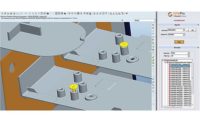Additive Manufacturing and End Of Arm Tooling
Innovative 3D-printed end-of-arm tooling enables systems integrator to lighten the load on a robotic packaging line.

Tharwat Fouad holds a pair of finished vacuum grippers for the Langen Group. After a light bead blasting, the parts were dyed per customer specifications and assembled with the mounting pieces. Photo courtesy Anubis 3D

The bottom of the gripper cup has a Swiss cheese pattern of channels leading to a vacuum hole at the top of the workpiece. Making these holes with conventional machining would have been impossible, but it was easy to accomplish with additive manufacturing. Photo courtesy Anubis 3D

This photo shows finished EOAT assembly attached to one of the packaging line’s robots. Compared to similar machined designs, the laser-sintered version uses less air but has far greater picking power. Photo courtesy Anubis 3D

A worker removes a laser-sintered part from the powder bed. Multiple parts or a complete assembly can be formed in a single laser-sintering run, and only light finishing is required before the parts can be used for production. Photo courtesy Anubis 3D

This photo shows a dual-box version of the completed vacuum assembly attached to a robot. Photo courtesy Anubis 3D





Necessity is the mother of invention, or so the proverb goes. Such was the case recently at The Langen Group, a manufacturer of automated packaging equipment in Mississauga, ON.
The company was working on a pick-and-pack line for a major American food producer. The robots were on order, and the company’s engineers began designing the end-of-arm tooling (EOAT) that would enable the robots to pick up wrapped, stacked crackers and place them into cardboard boxes.
Then, the engineers ran into a challenge.
To maximize speed without upsetting the center of gravity of the robots, the tooling—plus the weight of the product itself—couldn’t weigh more than 2 kilograms. However, the largest load of crackers on the line was 1.5 kilos for a ten-pack. That allowed only 500 grams for the tool.
Fortunately, help was just across town. Langen’s engineers contacted Anubis 3D, a division of Anubis Manufacturing Consultants Corp. in Mississauga. Anubis 3D is an additive manufacturing services firm with expertise in selective laser sintering, stereolithography, fused deposition modeling and direct metal laser sintering. The firm specializes in low-volume production of parts that are too expensive, too complex, or outright impossible to make through conventional manufacturing techniques.
“Meeting [the 500-gram tooling] requirement would have been impossible with aluminum and sheet metal,” says Tharwat Fouad, founder and president of Anubis Manufacturing Consultants and Anubis 3D. “To handle a heavier metal tool, they would have had to reorder larger robots, which would have been more expensive—and they were also under extreme time constraints.”
Weight wasn’t the only issue Anubis engineers had to deal with. For one thing, the tool had to be designed for quick connection and disconnection, so operators could change from one size to another without tightening and retightening nuts and bolts.
The tool also had to be flexible. “In all, there were two completely different configurations [of crackers]. There were different shapes and three box sizes consisting of two small boxes at a time and one large box,” says Fouad. “[Langen’s engineers] wanted a single tool that could handle it all, weigh no more than half a kilo, and they wanted it as soon as possible.”
Creating a Business
While many manufacturers saw value in additive manufacturing for prototyping applications, Fouad saw its potential for creating functional parts. He created Anubis 3D to fill that niche. “We found that most of the manufacturers that bought into plastics-based additive manufacturing did it for prototyping,” recalls Fouad. “But our reasons were completely different. We envisioned a number of opportunities for functional, end-use components, and felt additive manufacturing was the best technology for such applications.”
Fouad equipped Anubis 3D with a variety of machines for both metal and plastic additive manufacturing. Among them is the FORMIGA P 100 selective laser sintering system from EOS of North America Inc.
The system uses a 30-watt CO2 laser and precision optics to quickly and accurately “grow” parts as large as 200 by 250 by 330 millimeters, with layer thicknesses from 0.06 to 0.1 millimeter.
The system can create parts from a variety of engineering-grade polymers, including polyamides, polystyrenes, thermoplastic elastomers and polyaryletherketones.
“The system gives us the ability to build a virtually endless array of parts, using materials that are widely accepted in the industry,” Fouad says. “Within a few days of delivery, EOS had us up and running. The system was quite easy to learn. Now, several years later, we remain very happy with our decision.”
The benefits of laser sintering quickly became clear. One of Anubis’ first successes was an end-of-arm tool for a blow-molding application, which Fouad says inspired his team and opened their minds to what’s possible with plastic laser-sintering technology. Since then, they’ve designed a number of similar tools for injection molding and bottle-packaging customers.
The technology proved so useful, in fact, that Anubis 3D has since purchased two additional systems from EOS, including an EOSINT P 395, and is looking at a fourth.
Printing EOAT
Looking at the EOAT problem for the cracker packaging line, Anubis engineers realized that creating a traditional metal vacuum plate and shroud would have taken months to design and manufacture. Instead, Anubis engineers designed a lighter, streamlined set of components that provided four times the gripping force of standard vacuum grippers. What’s more, it took only a week to sinter the parts, assemble them, and test the new tool.
The material for the main vacuum part was nylon 12 (PA 2200 material from EOS). It was chosen for its flexibility and ability to sustain crash loads, and because it is certified as USP Class VI approved for food contact. The wall thickness of the vacuum cup was between 2 and 3.5 millimeters, which varied from section to section.
The parts were designed specifically for additive manufacturing with the help of software that optimizes the design of structures organically, following the lines of the geometry and adjusting the thickness as needed for strength or flexibility. Finite element analysis is built into the optimization to analyze stresses and strains on the structure.
“The creative part designs that additive manufacturing allows still have to be fully functional,” says Fouad. “Many of the plastic products we make at Anubis replace aluminum and other metals, so care must be taken to ensure structural integrity. We are completely confident that our additively manufactured plastic products will meet all customer requirements.”
Anubis loaded the material properties and vacuum requirements into the software, then used those calculations to determine how many and what size holes should be placed in the vacuum cup. The holes were laid out in a Swiss cheese pattern of channels leading to a primary vacuum hole at the top of the workpiece. This created a superior grip on the cracker stacks.
“The options we looked at were whether to have fewer, but larger, holes—or more, smaller ones,” says Fouad.
Initially, Anubis engineers duplicated the hole pattern from a traditional aluminum vacuum plate in the new nylon 12 part. When tests showed that gripping power could be better, the Anubis team created a new design with profiled holes and channels that could not have been manufactured conventionally. A larger number of these customized, smaller holes supplied a much stronger grab. Digital data from the final design guided the laser to melt the nylon and grow the new parts in the sintering machine.
“The efficiency of the new hole profile we developed with EOS technology enabled the redesigned gripper to suction so well you could actually hang on it with your own weight,” says Fouad. “Our customer had never seen that level of performance before.”
The vacuum grippers were delivered to Langen Group and installed on the newly arrived robots at the food producer’s plant. “To design and produce tooling capable of picking what we wanted, while still staying within the payload constraints of the robot, would have been impossible before,” says Robert Husnik, group engineering manager at Langen. “Due to the freedom provided by laser sintering plastics, we can now do the impossible.”
Additive Manufacturing Advantage
Achievements such as this are becoming the norm in manufacturing. That’s because laser sintering has the ability to create organic shapes that are unimaginable with conventional manufacturing techniques. Complex internal structures, smooth curves and geometries, undercuts and features that would be out of the reach of traditional tools are achievable when parts are built one layer at a time.
“I tell people that, unlike with traditional manufacturing, complexity is free with additive processes,” says Fouad. “A designer can come up with all sorts of wild ideas, and no one will complain. You can reduce part weight, maintain strength, and deliver nice-looking products with greater functionality, in less time and at lower cost than ever before. It’s a real manufacturing shift.”
The biggest challenge to greater acceptance of additive manufacturing is changing decades-old ways of thinking, says Fouad.
“The conversion from metal to plastic is possible, especially when it’s done scientifically,” he notes. “You need to focus on part geometry, and throw out traditional concerns over part complexity. Laser sintering has no such constraints. Companies afraid of change often contact us only when they’ve run out of options. However, there are many, many times when laser-sintered parts are a better alternative to CNC, one that can reduce costs and deliver a better end product, and do so without any investments in tooling.”
Looking forward, Fouad sees many opportunities. He and his team are currently engaged with the University of Ontario and Sheridan College (a technical school in nearby Oakville, ON), experimenting with what’s possible and finding new applications for laser-sintering technology. They also continue to expand their internal knowledge base.
“How to run the system was the easy part,” Fouad says. “Optimizing the process, understanding the polymers, and the mechanics of it all—those are areas that took a bit longer to learn. EOS was there with us through it all, to the point where we became experts ourselves on the equipment. Today, we’re right in the midst of a whole list of things we’ll continue to work on, to further our knowledge. It’s an exciting time for us.”
Looking for a reprint of this article?
From high-res PDFs to custom plaques, order your copy today!










